A GILT COPPER ALLOY FIGURE OF PADMAPANI LOKESHVARA NEPAL, 13TH/14TH CENTURY With inset gems and semi-precious stones. Himalayan Art Resources item no.16702 36.7 cm (14 1/2 in.) high Fußnoten An ethnic group from the Kathmandu Valley in Nepal, Newars are master artisans of unparalleled skill, who pass their expertise between generations and were frequently employed for major artistic projects in Tibet, Mongolia, and China. There is perhaps no better hallmark of the grace and sensitivity with which the Newars cast Buddhist sculptures than their classic representation of the young and lithe standing bodhisattva, exemplified by this elegant 13th-/14th-century gilt bronze of Padmapani Lokeshvara. Padmapani Lokeshvara, 'The Lord of the World Holding the Lotus', is a form of Avalokiteshvara. Considered the spiritual son of the Transcendental Buddha Amitabha, Avalokiteshvara achieved enlightenment eons ago, but waits to dissolve forever into nirvana; he vowed to guide and liberate all sentient beings from the bondage of death and rebirth, with all its inherent suffering. Therefore, he is considered the paradigm of perfected compassion, one of the key virtues a practitioner must develop towards his or her own Buddhahood. As his name suggests, Padmapani is shown holding a beautiful white lotus blossoming by his left shoulder. The stem of the lotus, now partially missing, would have passed through the ring-shaped opening formed by the thumb and index finger of his left hand. He stands in a gently bent pose, with his left foot stepping forward and his right hand in the boon-granting gesture. Two tenons projecting from the underside of each foot would have inserted the sculpture into a separately cast base. The leitmotif of the standing bodhisattva in a limber pose, with a bare torso, supple waist, and sheer lower garment, traces back to the golden age of Indian sculpture in the Gupta period (4th-to 6th-centuries). A famed standing Padmapani from Sarnath in the National Museum in New Delhi exemplifies this root (cf. Across the Silk Road, Beijing, 2016, pp.160-1, no.70). The Newars adopted and preserved this tradition, adding exaggerated narrow waists and swollen thighs by the 13th-century, in establishing the early Malla style. The present work is closely related to a slightly larger Padmapani from the same period held in the Rubin Museum of Art (C2005.16.8). The two are almost identical in their posture, crown formation, and lotus flower. They share the same prominent forehead, broad shoulders, and the supple musculature. Their large earrings, bejeweled necklace, and the billowing long sashes by the legs are also treated similarly. When discussing the Rubin example, Vajracharya concluded, "His ringlike ear ornament, loose anklets, lack of long necklace, and gentle appearance help us to date the image stylistically to the thirteenth or fourteenth century" (Nepalese Seasons: Rain and Ritual, New York, 2016, p.79). Another slightly smaller gilt bronze Avalokiteshvara from the same period is in the Museum Rietberg (Uhlig, On the Path to Enlightenment, Zurich, 1995, pp.96-7, no.51). Provenance Phillip Goldman Collection, London Sotheby's, New York, 21 March 2002, lot 53 Collection of Drs. Edmund and Julie Lewis, Chicago 銅鎏金蓮華手觀音像 尼泊爾,十三或十四世紀 鑲嵌雜寶。 喜馬拉雅藝術資源網16702號 高36.7釐米(14 1/2英吋) 1,600,000-2,400,000港幣 居住在尼泊爾加德滿都河谷之中的紐瓦爾人為舉世聞名的藝術匠師,他們將無與倫比的鑄像技藝在族內代代相傳,並且在西藏、蒙古與中原也留下了無數藝術珍寶。紐瓦爾大師鑄造的年輕而柔美的經典菩薩立像已成為其優雅與細膩的鑄造技藝的最佳寫照,此尊典雅的十三至十四世紀鎏金蓮華手便是這類菩薩立像的典範。 蓮華手菩薩為觀音菩薩形象之一。觀音菩薩為阿彌陀佛之子,於無量劫已悟道成佛,待進入涅磐。菩薩曾發願將接引眾生脫離生死輪迴之苦。因此,菩薩被尊為大慈大悲之化身,而慈悲亦成為每一位信徒必須具備之善行。 如其名所示,蓮華手菩薩手持一枝白蓮,花朵盛開於左肩。曾經穿過菩薩左手拇指與食指間圓環的蓮花莖現已部分遺失。菩薩站姿優雅,身體微微傾斜,左足稍前踏出,右手施予願印。 足下各有一凸榫,用於固定菩薩站立於單獨鑄造的底座。 此種軀幹袒露、腰肢柔勁、下著輕薄衣裙之菩薩造型可追溯至印度造像的黃金時代──笈多王朝(公元四至六世紀)。一尊新德里國家博物館珍藏的著名的鹿野苑蓮華手菩薩立像便佐證此種淵源(參見《Across the Silk Road》,北京,2016年,頁160-1,編號70)。紐瓦爾人借鑒並保留了這種印度傳統,在十三世紀前還將富有視覺張力的纖細腰肢與粗壯的大腿融入其中,形成了馬拉王朝早期之風格。 本尊造像與魯賓藝術博物館所藏一件同時代鑄造、體量稍大之蓮華手觀音像(編號C2005.16.8)關聯十分密切。兩尊造像之姿態、寶冠與蓮花皆一致,飽滿的前額、寬厚的肩膀與刻畫微妙的肌肉亦如出一轍,甚至連碩大的耳環、串珠項鍊以及
A GILT COPPER ALLOY FIGURE OF PADMAPANI LOKESHVARA NEPAL, 13TH/14TH CENTURY With inset gems and semi-precious stones. Himalayan Art Resources item no.16702 36.7 cm (14 1/2 in.) high Fußnoten An ethnic group from the Kathmandu Valley in Nepal, Newars are master artisans of unparalleled skill, who pass their expertise between generations and were frequently employed for major artistic projects in Tibet, Mongolia, and China. There is perhaps no better hallmark of the grace and sensitivity with which the Newars cast Buddhist sculptures than their classic representation of the young and lithe standing bodhisattva, exemplified by this elegant 13th-/14th-century gilt bronze of Padmapani Lokeshvara. Padmapani Lokeshvara, 'The Lord of the World Holding the Lotus', is a form of Avalokiteshvara. Considered the spiritual son of the Transcendental Buddha Amitabha, Avalokiteshvara achieved enlightenment eons ago, but waits to dissolve forever into nirvana; he vowed to guide and liberate all sentient beings from the bondage of death and rebirth, with all its inherent suffering. Therefore, he is considered the paradigm of perfected compassion, one of the key virtues a practitioner must develop towards his or her own Buddhahood. As his name suggests, Padmapani is shown holding a beautiful white lotus blossoming by his left shoulder. The stem of the lotus, now partially missing, would have passed through the ring-shaped opening formed by the thumb and index finger of his left hand. He stands in a gently bent pose, with his left foot stepping forward and his right hand in the boon-granting gesture. Two tenons projecting from the underside of each foot would have inserted the sculpture into a separately cast base. The leitmotif of the standing bodhisattva in a limber pose, with a bare torso, supple waist, and sheer lower garment, traces back to the golden age of Indian sculpture in the Gupta period (4th-to 6th-centuries). A famed standing Padmapani from Sarnath in the National Museum in New Delhi exemplifies this root (cf. Across the Silk Road, Beijing, 2016, pp.160-1, no.70). The Newars adopted and preserved this tradition, adding exaggerated narrow waists and swollen thighs by the 13th-century, in establishing the early Malla style. The present work is closely related to a slightly larger Padmapani from the same period held in the Rubin Museum of Art (C2005.16.8). The two are almost identical in their posture, crown formation, and lotus flower. They share the same prominent forehead, broad shoulders, and the supple musculature. Their large earrings, bejeweled necklace, and the billowing long sashes by the legs are also treated similarly. When discussing the Rubin example, Vajracharya concluded, "His ringlike ear ornament, loose anklets, lack of long necklace, and gentle appearance help us to date the image stylistically to the thirteenth or fourteenth century" (Nepalese Seasons: Rain and Ritual, New York, 2016, p.79). Another slightly smaller gilt bronze Avalokiteshvara from the same period is in the Museum Rietberg (Uhlig, On the Path to Enlightenment, Zurich, 1995, pp.96-7, no.51). Provenance Phillip Goldman Collection, London Sotheby's, New York, 21 March 2002, lot 53 Collection of Drs. Edmund and Julie Lewis, Chicago 銅鎏金蓮華手觀音像 尼泊爾,十三或十四世紀 鑲嵌雜寶。 喜馬拉雅藝術資源網16702號 高36.7釐米(14 1/2英吋) 1,600,000-2,400,000港幣 居住在尼泊爾加德滿都河谷之中的紐瓦爾人為舉世聞名的藝術匠師,他們將無與倫比的鑄像技藝在族內代代相傳,並且在西藏、蒙古與中原也留下了無數藝術珍寶。紐瓦爾大師鑄造的年輕而柔美的經典菩薩立像已成為其優雅與細膩的鑄造技藝的最佳寫照,此尊典雅的十三至十四世紀鎏金蓮華手便是這類菩薩立像的典範。 蓮華手菩薩為觀音菩薩形象之一。觀音菩薩為阿彌陀佛之子,於無量劫已悟道成佛,待進入涅磐。菩薩曾發願將接引眾生脫離生死輪迴之苦。因此,菩薩被尊為大慈大悲之化身,而慈悲亦成為每一位信徒必須具備之善行。 如其名所示,蓮華手菩薩手持一枝白蓮,花朵盛開於左肩。曾經穿過菩薩左手拇指與食指間圓環的蓮花莖現已部分遺失。菩薩站姿優雅,身體微微傾斜,左足稍前踏出,右手施予願印。 足下各有一凸榫,用於固定菩薩站立於單獨鑄造的底座。 此種軀幹袒露、腰肢柔勁、下著輕薄衣裙之菩薩造型可追溯至印度造像的黃金時代──笈多王朝(公元四至六世紀)。一尊新德里國家博物館珍藏的著名的鹿野苑蓮華手菩薩立像便佐證此種淵源(參見《Across the Silk Road》,北京,2016年,頁160-1,編號70)。紐瓦爾人借鑒並保留了這種印度傳統,在十三世紀前還將富有視覺張力的纖細腰肢與粗壯的大腿融入其中,形成了馬拉王朝早期之風格。 本尊造像與魯賓藝術博物館所藏一件同時代鑄造、體量稍大之蓮華手觀音像(編號C2005.16.8)關聯十分密切。兩尊造像之姿態、寶冠與蓮花皆一致,飽滿的前額、寬厚的肩膀與刻畫微妙的肌肉亦如出一轍,甚至連碩大的耳環、串珠項鍊以及

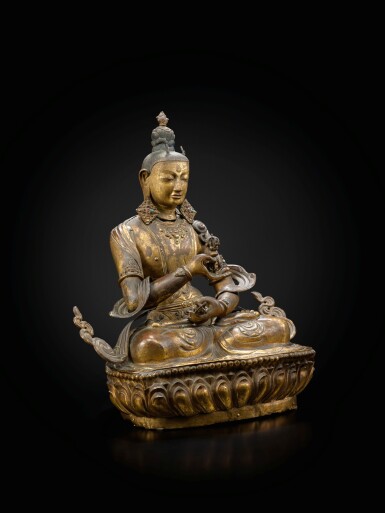
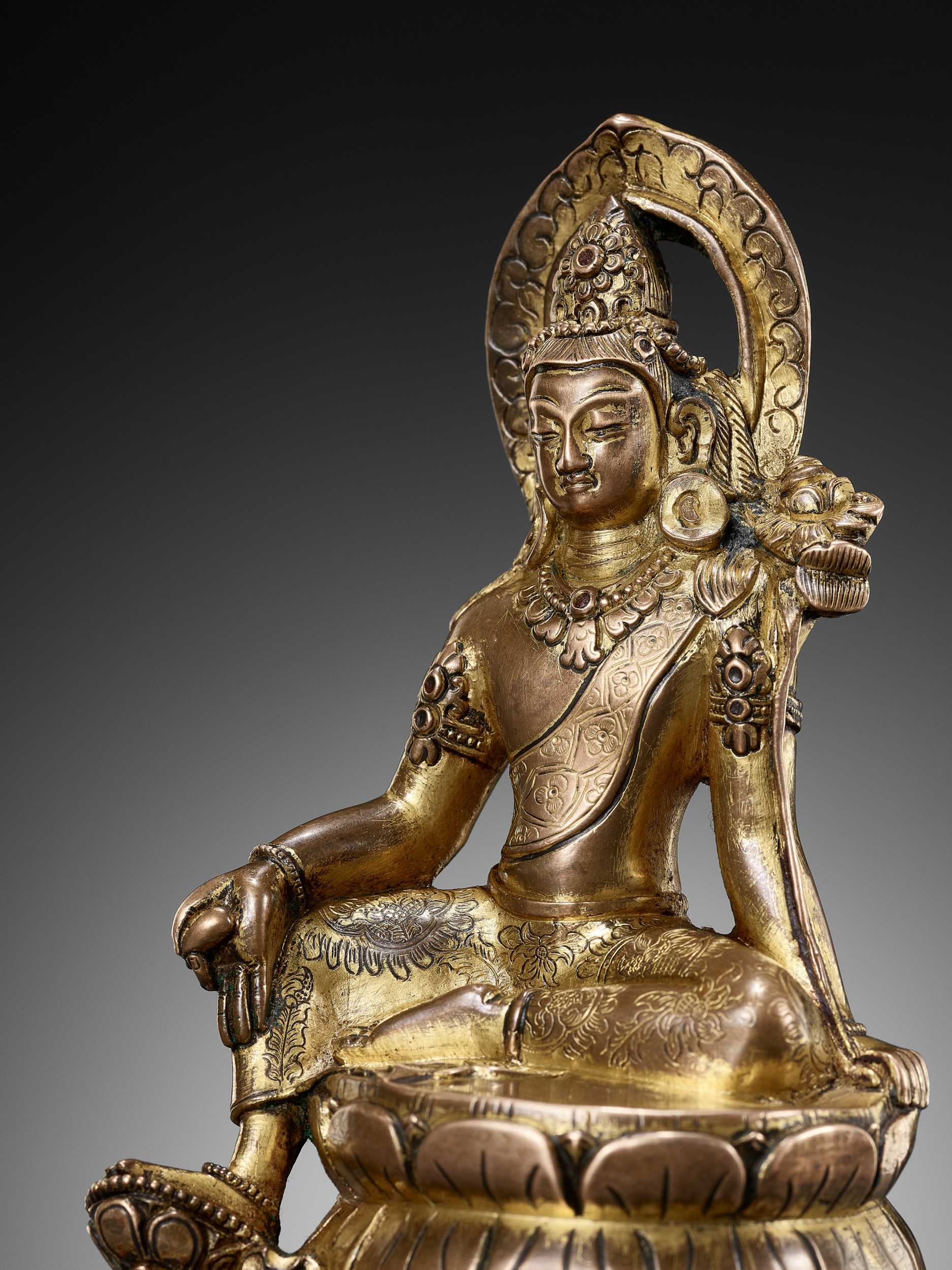
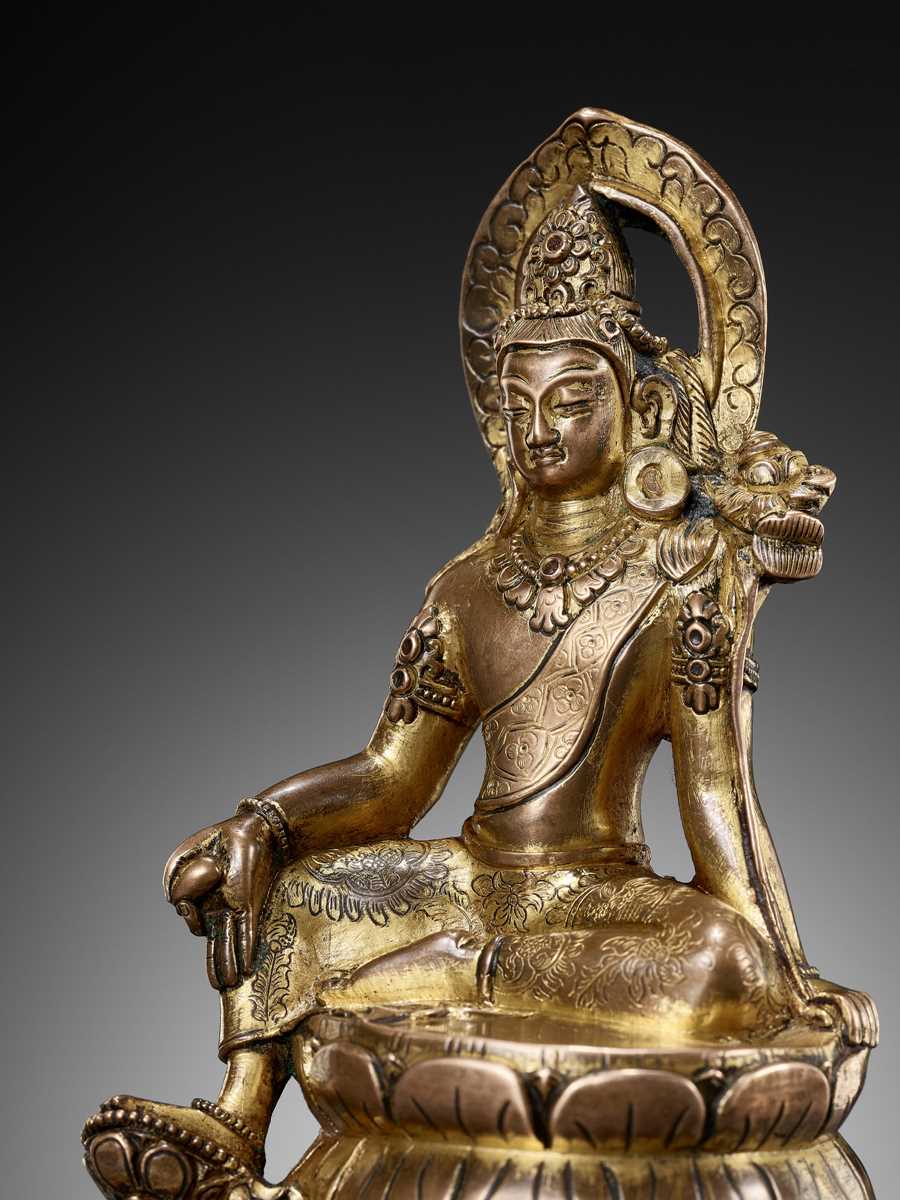







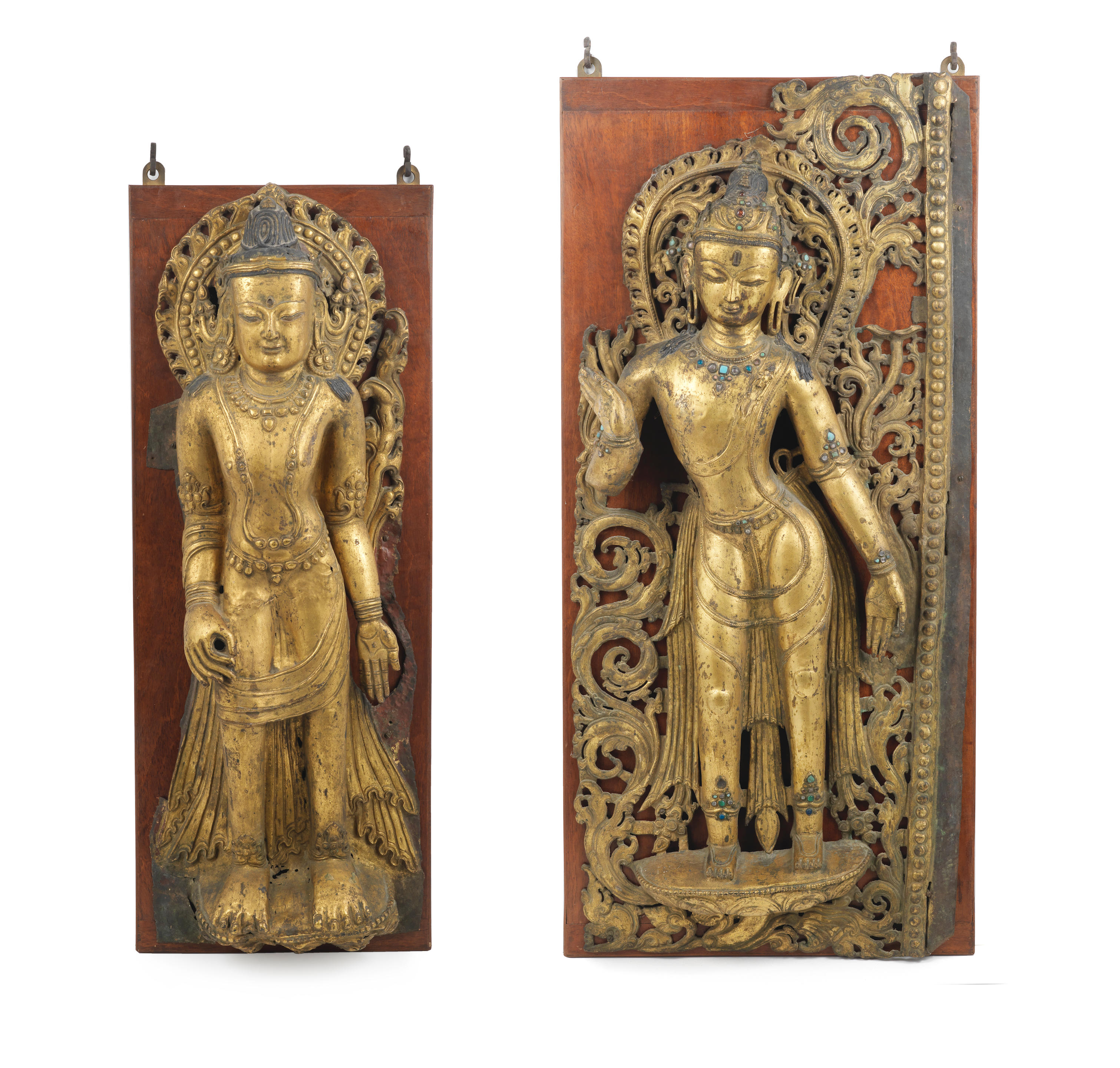
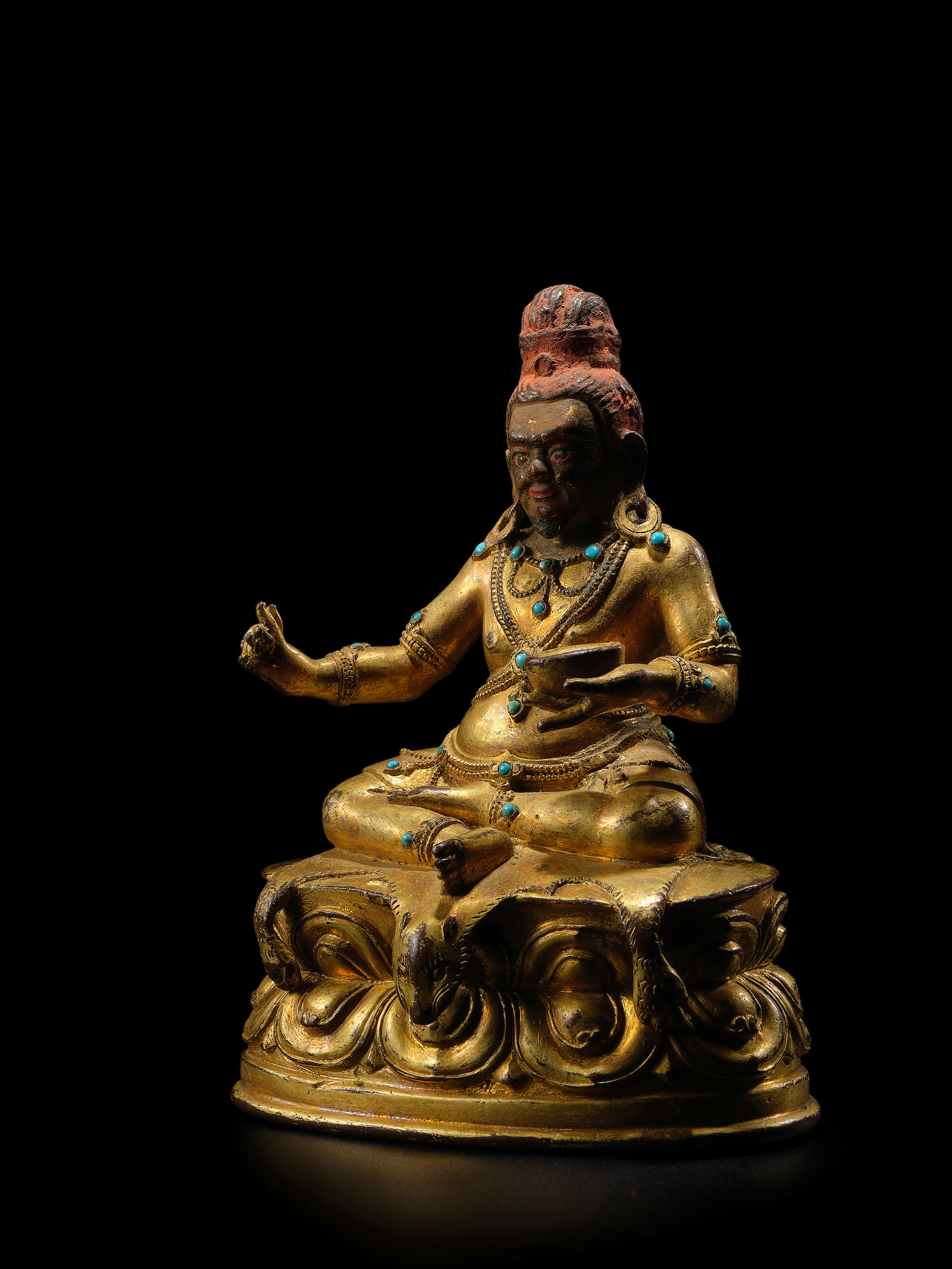

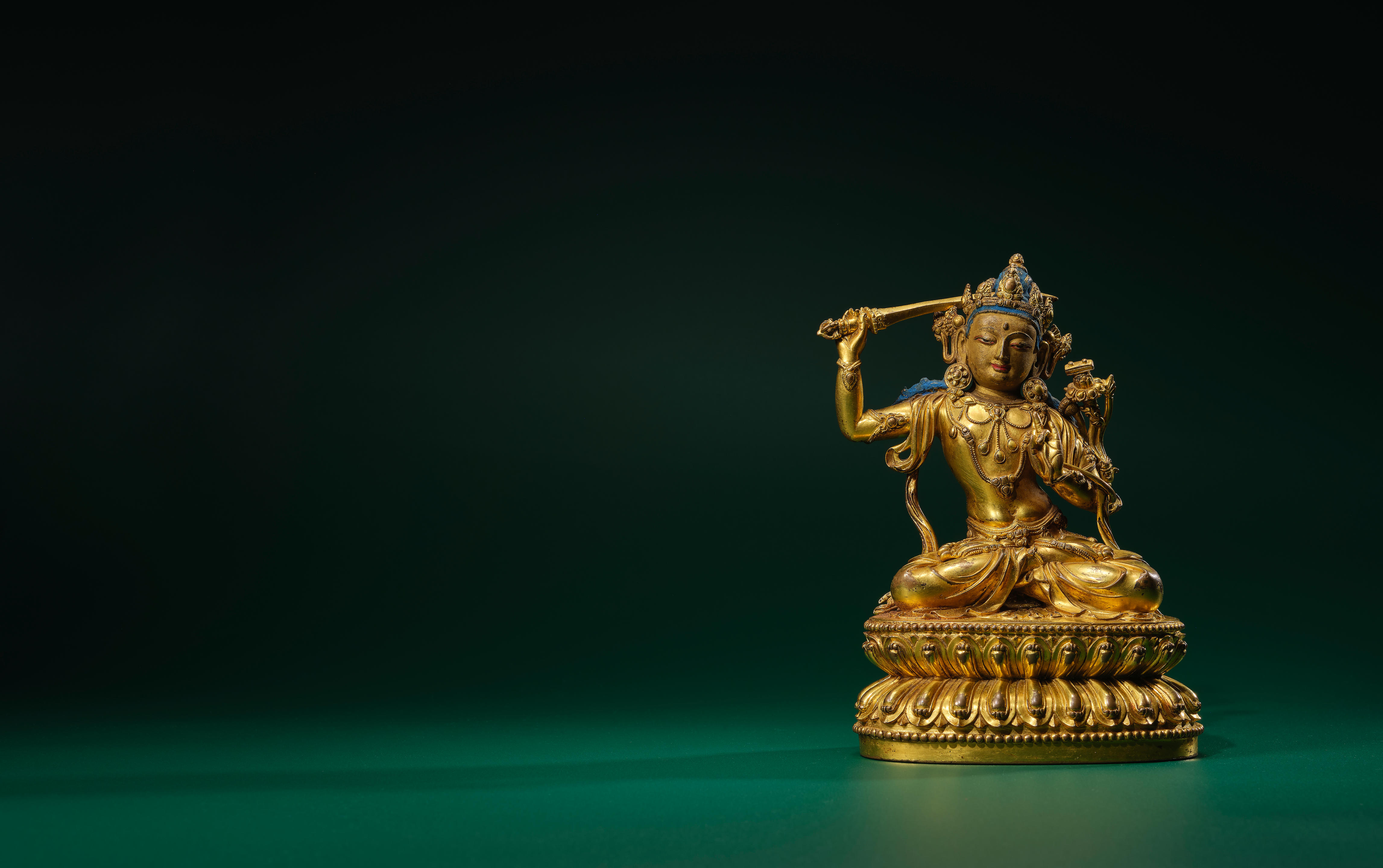
Try LotSearch and its premium features for 7 days - without any costs!
Be notified automatically about new items in upcoming auctions.
Create an alert